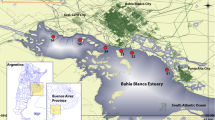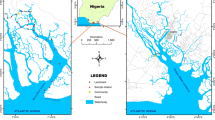Abstract
Polycyclic aromatic hydrocarbons (PAHs) are ubiquitous global pollutants that are lipophilic, bioaccumulative and can be both endocrine disruptors and carcinogens. In this study, we measured 18 PAHs among decapod shrimp samples (Palaemon spp.) collected during the spring and autumn from multiple locations along the Portuguese coastal, including local markets and aquaculture farms. ΣPAH concentrations in samples ranged from 3.14 to 320.48 ng/g (ww) with the highest value in this range detected in a sample provided from an aquaculture facility. Fifteen of the 18 scanned PAHs were present in shrimp samples. However, detectable concentrations (0.07 ng/g ww) of the carcinogenic benzo-a-pyrene occurred for a single sample only and approached method detection limits. No significant differences in shrimp ΣPAH concentrations were evident between the spring and autumn seasons. Target hazard quotient estimation suggested low probability of adverse health effects to consumers through consumption of shrimp from the study collection locations.



Similar content being viewed by others
References
Adami G, Barbieri P, Piselli S et al (2000) Detecting and characterising sources of persistent organic pollutants (PAHs and PCBs) in surface sediments of an industrialized area (harbour of Trieste, northern Adriatic Sea). J Environ Monit 2:261–265. https://doi.org/10.1039/b000995o
Adeleye AO, Jin H, Di Y et al (2016) Distribution and ecological risk of organic pollutants in the sediments and seafood of Yangtze Estuary and Hangzhou Bay, East China Sea. Sci Total Environ 541:1540–1548. https://doi.org/10.1016/j.scitotenv.2015.09.124
Amaraneni SR (2006) Distribution of pesticides, PAHs and heavy metals in prawn ponds near Kolleru lake wetland, India. Environ Int 32:294–302. https://doi.org/10.1016/j.envint.2005.06.001
ATSDR (1995) Toxic Substances Portal - Polycyclic Aromatic Hydrocarbons (PAHs). Agency Toxic Subst Dis Regist
Bolden AL, Rochester JR, Schultz K, Kwiatkowski CF (2017) Polycyclic aromatic hydrocarbons and female reproductive health: a scoping review. Reprod Toxicol 73:61–74. https://doi.org/10.1016/j.reprotox.2017.07.012
Carls MG, Holland L, Pihl E et al (2016) Polynuclear aromatic hydrocarbons in port valdez shrimp and sediment. Arch Environ Contam Toxicol 71:48–59. https://doi.org/10.1007/s00244-016-0279-3
Cavalieri EL, Higginbotham S, Rogan EG (1994) Dibenzo[a, l]pyrene: the most potent carcinogenic aromatic hydrocarbon. Polycycl Aromat Compd 6:177–183. https://doi.org/10.1080/10406639408031182
Commission Directive (EU) (2015) Commission Regulation (EU) 2015/1125 of 10 July 2015. Off J Eur Union 8–11
Conte F, Copat C, Longo S et al (2016) Polycyclic aromatic hydrocarbons in Haliotis tuberculata (Linnaeus, 1758) (Mollusca, Gastropoda): considerations on food safety and source investigation. Food Chem Toxicol 94:57–63. https://doi.org/10.1016/j.fct.2016.05.016
Crisafully R, Milhome MAL, Cavalcante RM et al (2008) Removal of some polycyclic aromatic hydrocarbons from petrochemical wastewater using low-cost adsorbents of natural origin. Bioresour Technol 99:4515–4519. https://doi.org/10.1016/j.biortech.2007.08.041
Das DN, Panda PK, Naik PP et al (2017) Phytotherapeutic approach: a new hope for polycyclic aromatic hydrocarbons induced cellular disorders, autophagic and apoptotic cell death. Toxicol Mech Methods 27:1–17. https://doi.org/10.1080/15376516.2016.1268228
Dosunmu MI, Oyo-Ita IO, Oyo-Ita OE (2016) Risk assessment of human exposure to polycyclic aromatic hydrocarbons via shrimp (Macrobrachium felicinum) consumption along the Imo River catchments, SE Nigeria. Environ Geochem Health 38:1333–1345. https://doi.org/10.1007/s10653-016-9799-z
EMA (1995) ICH Topic Q 2 (R1) validation of analytical procedures: text and methodology. Eur Med Agency Note Guid Valid Anal Proced Text Methodol 2:1–15. https://doi.org/10.32388/yokp53
European Union (2004) DIRECTIVE 2004/107/EC of the European Parliament and of the council of 15 December 2004. Off J Eur Union 12–25
FDA; NOAA (2010) Protocol for interpretation and use of sensory testing and analytical chemistry results for re-opening oil-impacted areas closed to seafood harvesting due to the deepwater horizon oil spill. 1–72
Fernando H, Ju H, Kakumanu R et al (2019) Distribution of petrogenic polycyclic aromatic hydrocarbons ( PAHs ) in seafood following Deepwater Horizon oil spill. Mar Pollut Bull 145:200–207. https://doi.org/10.1016/j.marpolbul.2019.05.015
Fogaça FH, Soares C, Oliveira M et al (2018) Polycyclic aromatic hydrocarbons bioaccessibility in seafood: culinary practices effects on dietary exposure. Environ Res 164:165–172. https://doi.org/10.1016/j.envres.2018.02.013
Hornung RW, Reed LD (1990) Estimation of average concentration in the presence of nondetectable values. Appl Occup Environ Hyg 5:46–51. https://doi.org/10.1080/1047322X.1990.10389587
IARC (2002) International agency for research on cancer iarc monographs on the evaluation of carcinogenic risks to humans. IARC Monogr 96:1–390
IARC (2010) IARC monographs on the evaluation of carcinogenic risks to humans. IARC Monogr 93:9–38. https://doi.org/10.1136/jcp.48.7.691-a
IPCS (2009) Principles and methods for the risk assessment of chemicals in food. Int J Environ Stud 68:251–252. https://doi.org/10.1080/00207233.2010.549617
JN (2019) Foco de poluição detetado no Rio Sado. https://www.jn.pt/local/noticias/setubal/setubal/foco-de-poluicao-detetado-no-rio-sado-10599369.html
Kao TH, Chen S, Huang CW et al (2014) Occurrence and exposure to polycyclic aromatic hydrocarbons in kindling-free-charcoal grilled meat products in Taiwan. Food Chem Toxicol 71:149–158. https://doi.org/10.1016/j.fct.2014.05.033
Kwon H, Lehotay SJ, Geis-Asteggiante L (2012) Variability of matrix effects in liquid and gas chromatography-mass spectrometry analysis of pesticide residues after QuEChERS sample preparation of different food crops. J Chromatogr A 1270:235–245. https://doi.org/10.1016/j.chroma.2012.10.059
Maia ML, Sousa S, Correia-Sá ML et al (2020) Organochlorine pesticides, brominated flame retardants, synthetic musks and polycyclic aromatic hydrocarbons in shrimps. An overview of occurrence and its implication on human exposure. Heliyon. https://doi.org/10.1016/j.heliyon.2020.e04870
Nagyová S, Tölgyessy P (2019) Validation including uncertainty estimation of a GC-MS/MS method for determination of selected halogenated priority substances in fish using rapid and efficient lipid removing sample preparation. Foods. https://doi.org/10.3390/foods8030101
Olayinka OO, Adewusi AA, Olujimi OO (2019) Polycyclic aromatic hydrocarbons in sediment and health risk of fish, crab and shrimp around atlas cove, Nigeria. J Heal Pollut 9:1–21
Ramalhosa MJ, Paíga P, Morais S et al (2009) Analysis of polycyclic aromatic hydrocarbons in fish: evaluation of a quick, easy, cheap, effective, rugged, and safe extraction method. J Sep Sci 32:3529–3538. https://doi.org/10.1002/jssc.200900351
Schroeder H (2011) Developmental brain and behavior toxicity of air pollutants: a focus on the effects of polycyclic aromatic hydrocarbons (PAHs). Crit Rev Environ Sci Technol 41:2026–2047. https://doi.org/10.1080/10643389.2010.495644
Scientific Committee on Food (2002) Opinion of the Scientific Committee on Food on the risks to human health of Polycyclic Aromatic Hydrocarbons in Food SCF/CS/CNTM/PAH/29 ADD1. Heal Consum Prot Dir A1–A194
Shilla DJ, Routh J (2018) Distribution, behavior, and sources of polycyclic aromatic hydrocarbon in the water column, sediments and biota of the Rufiji Estuary, Tanzania. Front Earth Sci 6:1–12. https://doi.org/10.3389/feart.2018.00070
Soltani N, Moore F, Keshavarzi B et al (2019) Ecotoxicology and environmental safety potentially toxic elements ( PTEs ) and polycyclic aromatic hydrocarbons (PAHs ) in fish and prawn in the Persian Gulf. Iran Ecotoxicol Environ Saf 173:251–265. https://doi.org/10.1016/j.ecoenv.2019.02.005
Sun RX, Lin Q, Ke CL et al (2016) Polycyclic aromatic hydrocarbons in surface sediments and marine organisms from the Daya Bay, South China. Mar Pollut Bull 103:325–332. https://doi.org/10.1016/j.marpolbul.2016.01.009
Tran VS, Ngo HH, Guo W et al (2015) Typical low cost biosorbents for adsorptive removal of specific organic pollutants from water. Bioresour Technol 182:353–363. https://doi.org/10.1016/j.biortech.2015.02.003
USEPA (2005) Guidelines for carcinogen risk assessment - EPA/630/P-03/001B. Risk Assess Forum 61(79):17960–18011
USEPA (2000) Science Policy Council. Environ Prot
USEPA (2021) IRIS assessment. https://iris.epa.gov/AtoZ/?list_type=alpha
WHO (2013) State of the science of endocrine disrupting chemicals - 2012
Wickliffe JK, Simon-Friedt B, Howard JL et al (2018) Consumption of fish and shrimp from southeast louisiana poses no unacceptable lifetime cancer risks attributable to high-priority polycyclic aromatic hydrocarbons. Risk Anal 38:1944–1961. https://doi.org/10.1111/risa.12985
Wilson MJ, Frickel S, Nguyen D et al (2014) A targeted health risk assessment following the deep water horizon oil spill: polycyclic aromatic hydrocarbon exposure in vietnamese-american shrimp consumers. Environ Health Perspect 152:152–159. https://doi.org/10.1289/ehp.1408684
Xia K, Hagood G, Childers C et al (2012) Polycyclic aromatic hydrocarbons (PAHs) in mississippi seafood from areas affected by the deepwater horizon oil spill. Environ Sci Technol 46:5310–5318. https://doi.org/10.1021/es2042433
Zhang G, Pan Z, Wang X et al (2015) Distribution and accumulation of polycyclic aromatic hydrocarbons (PAHs) in the food web of Nansi Lake, China. Environ Monit Assess 187:173. https://doi.org/10.1007/s10661-015-4362-4
Zhu H, Xu Y, Yan B et al (2016) Risk assessment of heavy metals contamination in sediment and aquatic animals in downstream waters affected by historical gold extraction in Northeast China. Hum Ecol Risk Assess 22:693–705. https://doi.org/10.1080/10807039.2015.1104626
Acknowledgements
This work was financially supported by Portuguese national funds through projects UIDB/50006/2020, UIDP/50006/2020, and LA/P/0008/2020, from the Fundação para a Ciência e a Tecnologia (FCT)/Ministério da Ciência, Tecnologia e Ensino Superior (MCTES). The authors also thank FCT and the European Union’s H2020 Research and Innovation Programme for funding through the project Systemic-An integrated approach to the challenge of sustainable food systems: adaptive and mitigatory strategies to address climate change and malnutrition. Maria Luz Maia is grateful to FCT and ESF (European Social Fund) through POCH (Programa Operacional Capital Humano) for the PhD grant SFRH/BD/128817/2017 and COVID/BD/151852/2022.
Author information
Authors and Affiliations
Contributions
MLM: investigation, formal analysis, visualization and writing—original draft; PP: investigation and formal analysis; MJR: methodology; supervision; validation and writing—review and editing; CDM: resources and writing—review and editing; VFD: supervision; validation and writing—review and editing; CC: validation and writing—review and editing.
Corresponding author
Ethics declarations
Conflict of interest
The authors have no conflict of interest to declare.
Additional information
Publisher's Note
Springer Nature remains neutral with regard to jurisdictional claims in published maps and institutional affiliations.
Supplementary Information
Below is the link to the electronic supplementary material.
Rights and permissions
About this article
Cite this article
Maia, M.L., Paíga, P., Ramalhosa, M.J. et al. Seasonal and Spatial Comparison of Polycyclic Aromatic Hydrocarbons Among Decapod Shrimp from Coastal Portugal. Bull Environ Contam Toxicol 109, 511–517 (2022). https://doi.org/10.1007/s00128-022-03562-y
Received:
Accepted:
Published:
Issue Date:
DOI: https://doi.org/10.1007/s00128-022-03562-y




